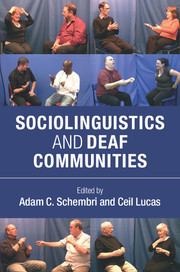Book contents
- Frontmatter
- Contents
- List of Figures
- List of Tables
- Notes on Contributors
- 1 Introduction
- 2 Sign languages in the world
- 3 Sign languages in contact
- 4 Variation and change in sign languages
- 5 Discourse analysis and sign languages
- 6 Language policy and planning in Deaf communities
- 7 Language attitudes in Deaf communities
- Index
- References
6 - Language policy and planning in Deaf communities
Published online by Cambridge University Press: 05 February 2015
- Frontmatter
- Contents
- List of Figures
- List of Tables
- Notes on Contributors
- 1 Introduction
- 2 Sign languages in the world
- 3 Sign languages in contact
- 4 Variation and change in sign languages
- 5 Discourse analysis and sign languages
- 6 Language policy and planning in Deaf communities
- 7 Language attitudes in Deaf communities
- Index
- References
Summary
Introduction: language policy and planning in Deaf communities
Language policies represent a kind of social intervention in a community. This is not new: for many decades nations and states have been inducing and even forcing people to adopt specific languages or to use specific forms of a language in their interactions. In this sense, the term “language policy” can be used with respect to rather diverse contexts. A language policy will determine decisions regarding the use of languages in a specific country or within linguistic communities (Cooper 1989). To this end, “language planning” will be followed to implement a specific language policy. Haugen (1959) referred in the following way to “language planning” when discussing language intervention in modern Norway:
Ideas concerning linguistics engineering have here reached out from the quiet studies of linguistics to the market place, where they have affected every citizen and his children.
(68)This passage gives us an idea of what linguistic policy is about: social intervention at the language level. For Haugen, language planning involves developing a normative orthography, grammar and dictionary to establish the prestigious dialect of a language in a specific community. The goal of language planners is to conduct language policies in specific communities. These decisions may or may not coincide with the community's interests in relation to language use, as reported by several researchers, including language planning for Deaf communities (for recent examples, see Behares, Brovetto, and Crespi 2012; Geraci 2012; Meir and Sandler 2008; Quadros 2012; Quer 2012; Schermer 2012a, 2012b). In this seminal publication, Haugen already underscores the question about changes in languages that are driven by political decisions. It is clear that language planning is a complex issue, since it will not only concern linguistic issues with regard to a language and its community, but it will also imply ethical aspects from the community perspectives, together with political ones: language planning means much more than establishing normative language standards, because it incorporates ideological and political stands with respect to a community.
- Type
- Chapter
- Information
- Sociolinguistics and Deaf Communities , pp. 120 - 145Publisher: Cambridge University PressPrint publication year: 2015
References
- 5
- Cited by



